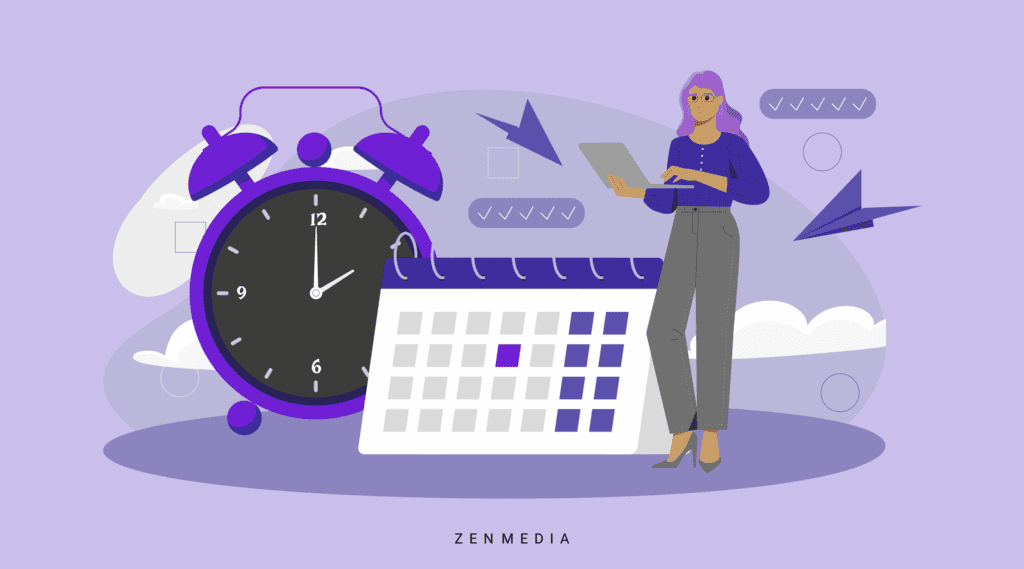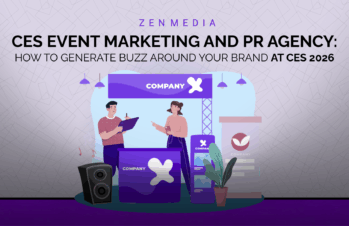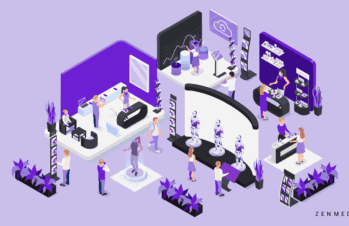While digital channels continue to dominate marketing strategies, 78% of organizers report that in-person events are their organization’s most impactful marketing channel—and smart businesses are taking note.
Over the past few years, attendees and businesses have made it known that they’re craving more than webinars and digital happy hours—they’re increasingly seeking authentic, human connections that can only happen offline. As a result, events have evolved from optional marketing activities to essential brand touchpoints.
And with 78% of business leaders citing face-to-face meetings as critical for building lasting relationships, brands that master the art of event hosting gain significant competitive advantages in customer acquisition, retention, and community building. Additionally, half of attendees in the B2B space report that offline connections offer superior networking opportunities compared to virtual alternatives.
This renaissance of in-person gatherings represents both challenges and opportunities for marketers ready to leverage the power of physical presence in an AI-saturated world. In this guide, we’ll walk you through our event planning checklist, covering everything from choosing the right event technology and keynote speakers to generating buzz across traditional marketing channels and making sure your next event runs smoothly!
Related reading: The Modern Roadshow: Why B2B Event Marketing Must Evolve
The Revival of In-Person Events: Why They Matter in 2025
Offline experiences have emerged as a powerful antidote to the digital saturation of virtual events.
This fatigue is further exacerbated when you consider 52% of consumers encounter between 5,000–10,000 ads a day through digital channels, meaning face-to-face interactions present a unique and dramatic way for brands to stand out against competitors.
The human connection factor has become even more valuable in the AI era. While artificial intelligence powers incredible efficiency gains, it simultaneously increases demand for authentic experiences that technology cannot replicate. This explains why 75% of customers report wanting more interaction with real humans as technology advances.
For modern event planners, implementing a SoLoMo (Social, Local, Mobile) framework is just one way brands can create multi-dimensional experiences that leverage technology without sacrificing authenticity. When looking across the events industry, it’s clear that hosting events has become an essential tool for community building, brand awareness, and engagement—particularly for businesses looking to convert digital impressions into meaningful relationships.
In-Person Event Strategy Fundamentals
In order to craft the perfect event marketing strategy, you need to start by establishing clear goals and parameters.
Defining Clear Objectives for Your Event
Before selecting venues or designing experiences, successful event hosts articulate precise objectives. These typically fall into three categories:
Lead generation focuses on collecting qualified prospects and moving them into your sales pipeline.
Brand awareness events aim to increase recognition and positive associations with your company.
Customer engagement events strengthen relationships with existing clients, potentially leading to expanded accounts and referrals.
Setting realistic, measurable goals requires specificity. Rather than aiming to “increase brand awareness,” commit to something more tangible, like “generating 50 qualified leads from companies with 100+ employees” or “securing 25 testimonials from existing customers.”
Choosing the Right Event Format
While it’s important to participate in industry events like trade shows, hosting standalone corporate events allows for greater control, curation, and engagement.
The format selection should align with your primary objectives. For instance, workshop series excel at demonstrating expertise and building thought leadership, while conferences generate significant brand exposure and networking opportunities. Intimate gatherings foster deeper connections with high-value prospects or customers. Each one serves a unique purpose that can help propel your business forward.
If you’re not ready to start planning a major event, you can still make a significant impact as an attendee. Elation Lighting, a leader in professional entertainment lighting solutions, executed this perfectly at LDI, the industry’s largest trade show. Instead of sitting on the sidelines, our team helped them seize the opportunity to transform their booth into an immersive product demo experience that drew crowds and sparked interest.
Our multi-channel marketing strategy built brand momentum and set the stage for their next launch. Through this approach, we were able to highlight the traffic advantages of a major industry event with the controlled experience of a hosted gathering.
Location Strategy: The Hyperlocal Approach
Location selection has become increasingly strategic as businesses recognize that “where” matters more than ever. Accounting fintech Pilot launched their entrepreneur exclusive event series in Nashville, a city brimming with energetic startups and talented business leaders. By tapping into the local area, our team helped Pilot reach their target audience and expand into a new market, setting them up for future events in other major cities.
This hyperlocal approach acknowledges that even global brands must create relevance within specific communities. Planners can achieve this by selecting event spaces that enhance a brand’s purpose—like historic buildings that reflect company values or innovative spaces that underscore technological leadership. Brining in local food favorites promotes local business while giving away themed swag that isn’t too kitschy shows locals you’ve done your research.
Building Your Event Team
Event planning doesn’t end with finding the right venue. You need a team of dedicated, experienced experts to help you attract attendees, handle ticket sales, gather event sponsors, generate buzz, select an event theme, and sort all the details before your first keynote.
Essential Roles for Successful Event Execution
Assembling the right team represents a critical success factor, requiring careful consideration of internal versus external resources. While many organizations handle certain aspects internally, partnering with specialized event marketing agencies provides access to established vendor relationships, creative expertise, and execution experience that can dramatically improve outcomes.
Add a Marketing Strategy to Your Planning Process
When evaluating event partners, look beyond logistics management to strategic capabilities that align with your business objectives. Find an agency that understands your event goals throughout every level of the planning process. This typically involves bringing in a group of people capable of executing a multi-channel approach across social media, paid ads, and digital marketing to ensure you reach your target audience, secure a great turnout, and amplify the results long after you leave the venue.
The right event marketing agency brings both tactical execution skills and strategic marketing insight that transforms gatherings into business-building opportunities on and offline. Plus, an agency can audit the experience to show you exactly what you need to do to make your next corporate event a success.
Selecting and Preparing Speakers and Presenters
Speaker selection significantly impacts event success, requiring deliberate choices between local and national presenters. As we discussed above, bringing in local experts can add regional credibility to drive attendance and engagement, while outside speakers bring in fresh ideas.
Speaker preparation also ensures content alignment with your brand positioning and event objectives. This involves more than reviewing presentations—it requires immersing speakers in your brand story, event themes, and target audience needs to ensure consistent messaging across all sessions.
Vendor Selection and Management
Creating cohesive experiences across all touchpoints demands careful vendor selection and management. From technology partners to catering and venue staff, each contributor influences attendee perceptions.
Successful event hosts create detailed specifications that align all vendors with the intended experience, then manage these relationships to ensure consistent delivery. Building long-term vendor relationships often leads to preferred pricing and priority scheduling for recurring events.
Crafting Meaningful Attendee Experiences and Networking Opportunities
The keynotes are important, but they’re not the only way to make a lasting impression. Add these elements to your next corporate event:
Event Flow and Programming Design
From hosting interactive panels to embracing icebreakers and team-building activities, creating the perfect agenda requires balancing structured content with networking opportunities. Most successful events follow a rhythm that alternates between focused learning and open connection time, recognizing that both elements deliver substantial value for all parties involved.
The most effective events maintain consistent energy levels throughout by strategically arranging high-impact sessions and providing appropriate transitions between different activities. This deliberate flow management prevents the energy dips that can diminish overall experience quality.
Designing Engaging Physical Spaces
Room layouts significantly influence connection opportunities by either facilitating or hindering natural interactions. For example, traditional theater-style arrangements maximize content delivery but minimize networking, while conversational groupings prioritize interaction over presentation efficiency.
Experiential elements that reflect your brand create memorable touchpoints throughout the venue. These range from subtle design elements like color schemes and materials to immersive installations that showcase your capabilities or values.
Find the right balance for your next corporate event by leaning into your theme and considering the types of people who will attend. If you’re hosting a trade show, ensure there’s enough room on the floor for everyone to demo their products with ease. If you’re hosting a large event like a conference, use design elements and signage to subtly guide crowds around the space and encourage networking opportunities.
Technology Integration for Modern Events
Registration and check-in systems represent critical technology touchpoints that set attendance expectations. Beyond streamlining arrival processes, these systems gather valuable data and contact information that becomes the foundation for your post-event marketing efforts.
Mobile apps and digital engagement tools extend the event experience before, during, and after the gathering. The most effective applications facilitate connections between attendees, provide seamless access to event information, encourage engagement on social media, and enable real-time feedback collection.
Borrow from Virtual Events
Although we aren’t focusing on virtual events in this guide, it’s important to maintain hybrid options to increase accessibility. And while hybrid options expand reach beyond physical attendees, they require deliberate design to provide meaningful experiences for remote participants. Rather than simply broadcasting content, successful hybrid events create parallel but equally valuable journeys for both in-person and virtual attendees.
Attendee Acquisition and Engagement for Your Next Corporate Event
From sending early bird promotions to building social media campaigns and connecting with your network of attendees after the event, make the most of your event ROI through acquisition and engagement.
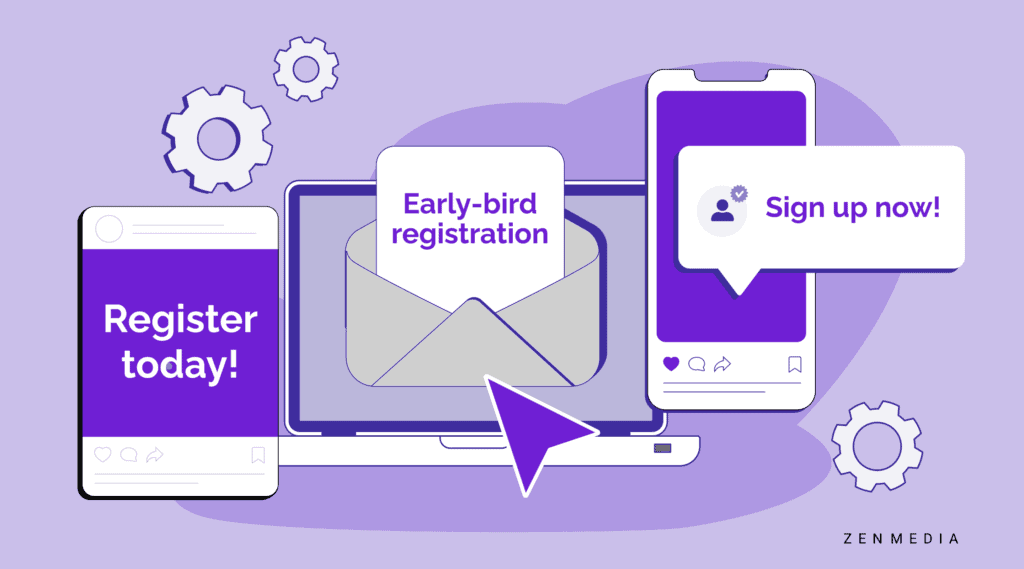
Developing Your Event Promotion Strategy
Multi-channel marketing approaches deliver superior results compared to single-platform strategies. Our campaign with Elation demonstrated this principle by coordinating messaging across paid, owned, and earned media to create reinforcing touchpoints that drove registration and anticipation.
Leveraging social media for registration and engagement requires platform-specific strategies that align with user expectations. LinkedIn campaigns emphasize professional benefits, while Instagram content highlights experiential elements through compelling visuals. Lean on your event marketing agency team to find the right balance of digital promos.
Related reading: The Four Types of Media: Rented, Owned, Paid, Earned
Creating Pre-Event Excitement
Content teasers and speaker highlights build anticipation when strategically released leading up to the event—they can even boost your early bird registration rates!
Instead of revealing programming all at once, successful event planners create information cascades that maintain engagement throughout the pre-event period.
FOMO-inducing communications leverage social proof to demonstrate anticipated value through testimonials from past attendees, speaker credentials, and exclusive content previews. These elements transform standard promotional materials into compelling invitations that drive registration.
Personalization Throughout the Attendee Journey
Customized communications before, during, and after the event demonstrate attendee value and increase engagement. This begins with registration acknowledgments tailored to specific interests and continues through personalized agendas and follow-up resources.
Segmented experiences for different attendee types recognize that participants have varying needs and interests, especially at large events. Creating parallel tracks for newcomers versus experienced practitioners, or technical versus business-focused attendees, increases perceived value while streamlining content development.
Memorable Touchpoints and Takeaways for Different Event Types
Pamphlets, keychains, and tote bags are out—think outside the box for your next event!
Reimagining Event Swag for 2025
Problem-solving promotional items, useful gadgets, and engaging products have replaced generic branded merchandise as effective event takeaways. The best event gifts address specific needs related to your industry or offer utility that creates ongoing brand visibility in relevant contexts.
Digital takeaways extend value beyond the event by providing resources that help attendees implement what they’ve learned, while fun twists on classic merchandise make for memorable moments. Aeroflow Breastpumps leaned into something their audience was incredibly familiar with when they gave out squeezable, breast-shaped stress balls on Pumpspotting’s Feel Better, Feed Better bus tour. Moms received helpful advice and breastfeeding consultations, but they also had fun connecting with other parents and relieving their stress—both on-site and online, quickly turning this clever merch into a social media sensation.
Food and Beverage Considerations
As we mentioned, local culinary experiences are powerful ways to enhance event memorability. Featuring regional specialties or partnering with notable local establishments creates talking points while supporting community integration. You can even use social media and newsletters to invite attendees to vote on their favorite food spots before the event. This will give your team an idea of what attendees like while also encouraging engagement.
Be sure to add dietary accommodations to your event planning checklist, as these have evolved from special requests to standard practice. Most successful events now proactively address common restrictions and preferences by offering a variety of food options, demonstrating attendee-centricity while avoiding potentially negative experiences.
When it comes to drinks, the decision between serving alcohol or maintaining alcohol-free environments requires careful consideration of your industry, audience expectations, and event objectives. While alcohol can facilitate social connections, it may also create liability concerns or exclude certain attendees. If you’re offering alcohol, be sure to include mocktails and other alcohol-free options. Adding a coffee bar, different teas, and other refreshing drinks will help your event stand out. Bonus points for creating signature drinks to highlight industry-wide trends, your company, or the event theme.
Creating Shareable Moments
When strategically designed, photo opportunities and social media integration transform attendees into content creators.
Think beyond hashtags and isolated photo booths. Instead, create visually compelling settings with appropriate lighting and branded elements to encourage spontaneous sharing while ensuring consistent representation.
User-generated content amplifies event reach when organizers establish clear hashtags and provide sharing incentives. The most effective strategies make sharing advantageous for attendees through contests, recognition, or exclusive content access.
Setting and Reaching Event Goals: Measurement and Optimization
We all know trade shows, conferences, and exhibits don’t end when everyone heads home. Here are some ways to measure and optimize your business event.]
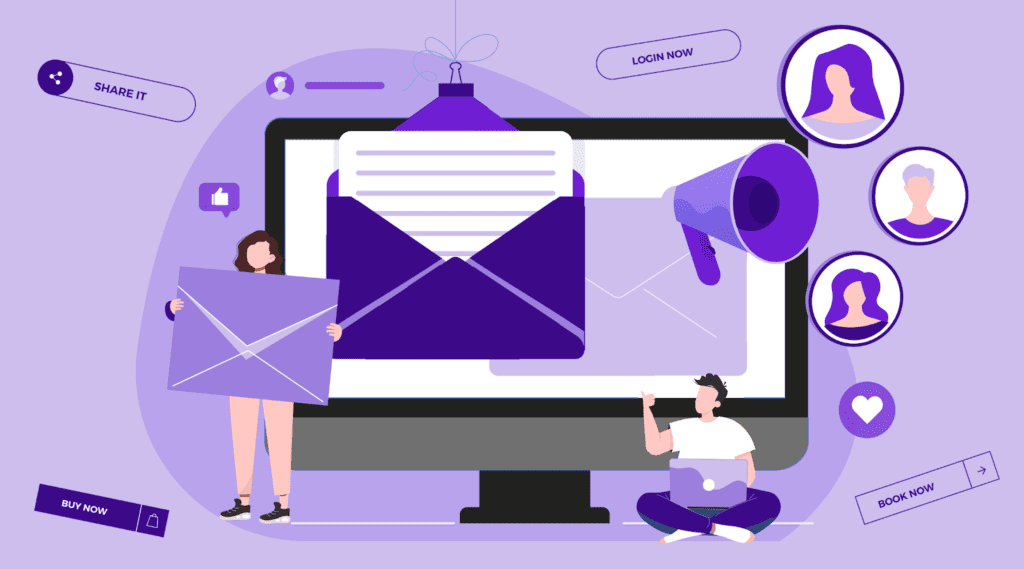
Setting Up Comprehensive Tracking Systems
When properly implemented, digital touchpoints throughout the event experience enable granular performance measurement.
QR codes linking to personalized landing pages create trackable pathways that connect physical interactions to digital behaviors. They can also provide access to exclusive content and helpful resources. Whatever your goals are, there’s plenty of event software available to help you track everything from event attendance to sentiment and user patterns.
These systems reveal which elements generate the most engagement, how attendees navigate your event, and which touchpoints correlate with subsequent conversion activities. This information guides both real-time adjustments and planning for future gatherings.
Key Performance Indicators for Event Hosts
Beyond attendance, engagement quality metrics provide deeper insight into event effectiveness.
Tracking session retention, participation in interactive elements, and resource downloads reveals attendee interest patterns more accurately than head counts alone.
Additionally, lead scoring and qualification processes transform raw attendee data into actionable sales intelligence. The most sophisticated systems incorporate behavior signals from the event into your customer relationship management system, enabling personalized follow-up based on demonstrated interests.
Related reading: Trends, Tools, and Strategies Shaping Customer Relationship Management Systems for B2Bs
Post-Event Analysis and Follow-Up
Attendee feedback mechanisms should balance response rates with data quality.
Send short, focused surveys immediately following the event to generate higher completion rates and opt for delayed but more comprehensive questionnaires to gather deeper insights from your most engaged participants.
And converting event connections to business relationships requires systematic follow-up procedures that maintain momentum without creating pressure. Successful programs typically include immediate appreciation messages, resource sharing within the first week, and personalized outreach based on specific interactions.
Event Planning 101: Build Repeatable Frameworks
Save time by creating event planning templates you can customize and implement anywhere, at any time.
Creating Scalable, Replicable Event Models
Our approach to creating a customizable event series for Pilot demonstrated how establishing core templates enables efficient expansion across multiple markets. Building a standardized framework allows for rapid deployment while accommodating local customization and making quick changes as necessary.
Regardless of industry or event type, ensure you create a replicable model that maintains consistent brand values while adapting to different markets. This is accomplished through standardized elements that ensure quality with flexible components that address local preferences.
Documentation and Process Development
Balancing standardization with local customization requires explicit guidance regarding which elements must remain consistent and where adaptation is encouraged. The most effective frameworks document both the “what” and the “why” behind each component, enabling teams to make appropriate judgment calls when unexpected situations arise.
Adapting to different markets while maintaining brand consistency demands clear brand standards coupled with cultural intelligence. Successful event hosts conduct local research before entering new markets, identifying both practical considerations like venue availability and cultural factors that influence programming decisions.
Leaning on an event marketing agency can help you tap into the flairs of different markets without sacrificing the essence of your event.
Key Success Factors for Hosting Events in 2025 and Beyond
The revival of in-person events reflects fundamental human needs that technology cannot replace. As digital channels become increasingly saturated, creating meaningful offline experiences provides brands with powerful differentiation opportunities.
Successful event hosting in 2025 combines strategic clarity with operational excellence. Beginning with precise objectives, selecting appropriate formats, and creating memorable experiences transforms standard gatherings into powerful business-building tools.
Measurement frameworks that connect event activities to business outcomes enable continuous improvement while demonstrating return on investment. This accountability transforms events from cost centers to growth engines within your marketing ecosystem.
Most importantly, authentic connection remains the central value proposition when meeting in person. While technology enhances capabilities, the fundamental appeal lies in creating spaces where meaningful human interactions occur. Lean into these sentiments to yield lasting rewards.
Ready to transform your event strategy? Zen Media specializes in creating memorable, measurable event experiences that build your brand while generating qualified leads. Contact us today to discuss how our integrated approach can take your next gathering from ordinary to extraordinary.

